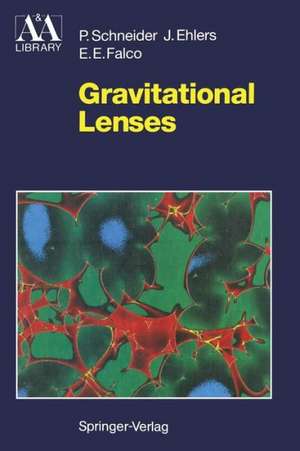Gravitational Lenses: Astronomy and Astrophysics Library
Autor Peter Schneider, Jürgen Ehlers, Emilio E. Falcoen Limba Engleză Paperback – 17 sep 2011
Din seria Astronomy and Astrophysics Library
- 17%
 Preț: 496.37 lei
Preț: 496.37 lei - 15%
 Preț: 601.60 lei
Preț: 601.60 lei - 19%
 Preț: 455.24 lei
Preț: 455.24 lei - 17%
 Preț: 525.72 lei
Preț: 525.72 lei - 13%
 Preț: 393.37 lei
Preț: 393.37 lei - 19%
 Preț: 524.14 lei
Preț: 524.14 lei - 17%
 Preț: 393.90 lei
Preț: 393.90 lei - 15%
 Preț: 647.40 lei
Preț: 647.40 lei - 15%
 Preț: 541.54 lei
Preț: 541.54 lei - 17%
 Preț: 362.70 lei
Preț: 362.70 lei - 18%
 Preț: 1006.55 lei
Preț: 1006.55 lei - 18%
 Preț: 745.33 lei
Preț: 745.33 lei - 15%
 Preț: 641.20 lei
Preț: 641.20 lei -
 Preț: 397.38 lei
Preț: 397.38 lei - 15%
 Preț: 598.21 lei
Preț: 598.21 lei - 15%
 Preț: 658.05 lei
Preț: 658.05 lei - 23%
 Preț: 815.07 lei
Preț: 815.07 lei -
 Preț: 409.89 lei
Preț: 409.89 lei - 15%
 Preț: 610.61 lei
Preț: 610.61 lei -
 Preț: 393.90 lei
Preț: 393.90 lei - 15%
 Preț: 655.27 lei
Preț: 655.27 lei - 18%
 Preț: 951.47 lei
Preț: 951.47 lei - 18%
 Preț: 960.42 lei
Preț: 960.42 lei - 18%
 Preț: 1397.68 lei
Preț: 1397.68 lei - 18%
 Preț: 959.98 lei
Preț: 959.98 lei - 18%
 Preț: 1012.08 lei
Preț: 1012.08 lei - 15%
 Preț: 481.03 lei
Preț: 481.03 lei - 15%
 Preț: 672.43 lei
Preț: 672.43 lei -
 Preț: 413.15 lei
Preț: 413.15 lei - 18%
 Preț: 1554.72 lei
Preț: 1554.72 lei - 18%
 Preț: 1410.63 lei
Preț: 1410.63 lei -
 Preț: 390.08 lei
Preț: 390.08 lei - 18%
 Preț: 944.99 lei
Preț: 944.99 lei - 19%
 Preț: 502.94 lei
Preț: 502.94 lei - 15%
 Preț: 654.12 lei
Preț: 654.12 lei - 24%
 Preț: 851.62 lei
Preț: 851.62 lei - 19%
 Preț: 515.32 lei
Preț: 515.32 lei - 15%
 Preț: 663.14 lei
Preț: 663.14 lei - 15%
 Preț: 656.43 lei
Preț: 656.43 lei - 18%
 Preț: 741.68 lei
Preț: 741.68 lei - 15%
 Preț: 647.40 lei
Preț: 647.40 lei -
 Preț: 388.90 lei
Preț: 388.90 lei - 18%
 Preț: 1223.11 lei
Preț: 1223.11 lei - 15%
 Preț: 651.51 lei
Preț: 651.51 lei - 15%
 Preț: 655.27 lei
Preț: 655.27 lei -
 Preț: 347.59 lei
Preț: 347.59 lei - 18%
 Preț: 794.39 lei
Preț: 794.39 lei
Preț: 957.75 lei
Preț vechi: 1167.99 lei
-18% Nou
Puncte Express: 1437
Preț estimativ în valută:
183.27€ • 189.07$ • 152.94£
183.27€ • 189.07$ • 152.94£
Carte tipărită la comandă
Livrare economică 27 martie-10 aprilie
Preluare comenzi: 021 569.72.76
Specificații
ISBN-13: 9781461276555
ISBN-10: 1461276551
Pagini: 576
Ilustrații: XIV, 560 p.
Dimensiuni: 155 x 235 x 30 mm
Greutate: 0.8 kg
Ediția:Softcover reprint of the original 1st ed. 1992
Editura: Springer
Colecția Springer
Seria Astronomy and Astrophysics Library
Locul publicării:New York, NY, United States
ISBN-10: 1461276551
Pagini: 576
Ilustrații: XIV, 560 p.
Dimensiuni: 155 x 235 x 30 mm
Greutate: 0.8 kg
Ediția:Softcover reprint of the original 1st ed. 1992
Editura: Springer
Colecția Springer
Seria Astronomy and Astrophysics Library
Locul publicării:New York, NY, United States
Public țintă
ResearchCuprins
1. Introduction.- 1.1 Historical remarks.- 1.2 Outline of the book.- 1.3 Remarks about notation.- 2. Basic facts and the observational situation.- 2.1 The Schwarzschild lens.- 2.2 The general lens.- 2.3 The magnification factor.- 2.4 Observing gravitational lens systems.- 2.5 Known gravitational lens systems.- 3. Optics in curved spacetime.- 3.1 The vacuum Maxwell equations.- 3.2 Locally approximately plane waves.- 3.3 Fermat’s principle.- 3.4 Geometry of ray bundles.- 3.5 Distances based on light rays. Caustics.- 3.6 Luminosity, flux and intensity.- 4. Derivation of the lens equation.- 4.1 Einstein’s gravitational field equation.- 4.2 Approximate metrics of isolated, slowly moving, non-compact matter distributions.- 4.3 Light deflection by quasistationary, isolated mass distributions.- 4.4 Summary of Friedmann-Lemaître cosmological models.- 4.5 Light propagation and redshift-distance relations in homogeneous and inhomogeneous model universes.- 4.6 The lens mapping in cosmology.- 4.7 Wave optics in lens theory.- 5. Properties of the lens mapping.- 5.1 Basic equations of the lens theory.- 5.2 Magnification and critical curves.- 5.3 Time delay and Fermat’s principle.- 5.4 Two general theorems about gravitational lensing.- 5.5 The topography of time delay (Fermat) surfaces.- 6. Lensing near critical points.- 6.1 The lens mapping near ordinary images.- 6.2 Stable singularities of lens mappings.- 6.3 Stable singularities of one-parameter families of lens mappings; metamorphoses.- 6.4 Magnification of extended sources near folds.- 7. Wave optics in gravitational lensing.- 7.1 Preliminaries; magnification of ordinary images.- 7.2 Magnification near isolated caustic points.- 7.3 Magnification near fold catastrophes.- 8. Simple lens models.- 8.1 Axially symmetric lenses.-8.2 Lenses with perturbed symmetry (Quadrupole lenses).- 8.3 The two point-mass lens.- 8.4 Lenses with elliptical symmetry.- 8.5 Marginal lenses.- 8.6 Generic properties of “elliptical lenses”.- 9. Multiple light deflection.- 9.1 The multiple lens-plane theory.- 9.2 Time delay and Fermat’s principle.- 9.3 The generalized quadrupole lens.- 10. Numerical methods.- 10.1 Roots of one-dimensional equations.- 10.2 Images of extended sources.- 10.3 Interactive methods for model fitting.- 10.4 Grid search methods.- 10.5 Transport of images.- 10.6 Ray shooting.- 10.7 Constructing lens and source models from resolved images.- 11. Statistical gravitational lensing: General considerations.- 11.1 Cross-sections.- 11.2 The random star field.- 11.3 Probabilities in a clumpy universe.- 11.4 Light propagation in inhomogeneous universes.- 11.5 Maximum probabilities.- 12. Statistical gravitational lensing: Applications.- 12.1 Amplification bias and the luminosity function of QSOs.- 12.2 Statistics of multiply imaged sources.- 12.3 QSO-galaxy associations.- 12.4 Microlensing: Astrophysical discussion.- 12.5 The amplification bias: Detailed discussion.- 12.6 Distortion of images.- 12.7 Lensing of supernovae.- 12.8 Further applications of statistical lensing.- 13. Gravitational lenses as astrophysical tools.- 13.1 Estimation of model parameters.- 13.2 Arcs in clusters of galaxies.- 13.3 Additional applications.- 13.4 Miscellaneous topics.- References.- Index of Individual Objects.
